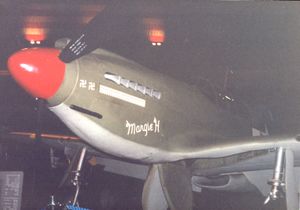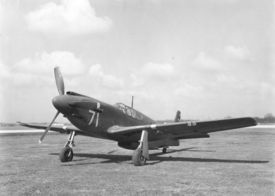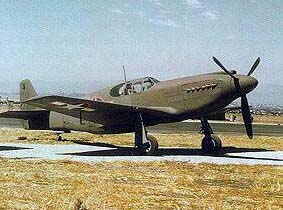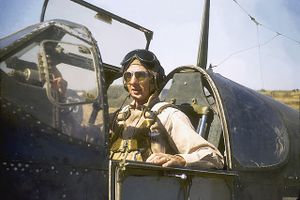PlaneSpottingWorld welcomes all new members! Please gives your ideas at the Terminal.
North American A-36
| A-36 Apache/Invader | |
|---|---|
| North American A-36A | |
| Type | Ground-attack/dive bomber |
| Manufacturer | North American Aviation |
| Designed by | Edgar Schmeud |
| Maiden flight | October 1942 |
| Introduced | 1942 |
| Retired | 1945 |
| Primary users | United States Army Air Forces Civilian air racer |
| Number built | 500 |
| Unit cost | $49,000 [1] |
| Developed from | P-51 Mustang |
The North American A-36A Apache/Invader was the ground-attack/dive bomber version of the North American P-51 Mustang, from which it could be distinguished by the presence of rectangular, slatted dive brakes above and below the wings. A total of 500 A-36A dive bombers served in North Africa, the Mediterranean, Italy and the China-Burma-India theater during World War II before being withdrawn from operational use in 1944.
Contents
Design and development
With the introduction of the North American Mustang I with the RAF Army Co-operation Squadrons in February 1942, the new fighter began combat missions as a low-altitude reconnaissance and ground-support aircraft. Supplementing the Curtiss P-40 Tomahawks already in service, Mustang Is were first supplied to No. 26 Squadron RAF, then rapidly deployed to ten additional squadrons by June 1942. Drawing first blood over Dieppe on 19 August 1942, a No. 414 (RCAF) Squadron Mustang downed the formidable Focke-Wulf Fw 190, the first victory for a Mustang. [2] Despite the limiting high-altitude performance of the Allison V-1710 engine, the RAF was enthusiastic about its new mount which "performed magnificently[3] ."
During the Mustang I's successful combat initiation, North American's president Howard "Dutch" Kindelberger pressed the newly redesignated US Army Air Force(USAAF) for a fighter contract for the essentially similar P-51, 47 of which had passed into the USAAF when the Lend-Lease contract with Britain ran out of funds. The P-51 utilized four 20 mm Hispano wing cannons replacing the original four .30 caliber and two .50 caliber Browning machine guns mounted in the wings and two .50 caliber "chin" machine guns. No funds were available for new fighter contracts in Fiscal Year 1942 but General Oliver Echols wanted to ensure the P-51 remained in production. [4]
Since appropriations were available for an attack aircraft, Echols specified modifications to the P-51 to turn it into a dive bomber. The contract for 500 A-36A aircraft fitted with bomb racks and dive brakes was in place (16 April 1942) [5] even before the first flight of the P-51 in May 1942. [6] With orders on the books, North American Aviation (NAA) began modifying the P-51 to accept the bomb shackles that were already tested in a "long-range ferry" program that the RAF had stipulated [7]. Engineering studies totalling 40,000 hours and wind tunnel testing with a 1/8 scale model was completed in June 1942. Utilizing the basic P-51 airframe and Allison engine, structural reinforcing "beefed up" several high stress areas and "a set of hydraulically operated dive brakes were installed in each main wing plane." [8] Due to the slightly inboard placement of the bomb racks and unique installation of four cast aluminum dive brakes, a complete redesign of the P-51 wing was required. [9]
The USAAF also had 310 P-51As on order that were differentiated by having provision for drop tanks, an armament of only four, wing-mounted 0.50 in Browning machine guns and an Allison V-1710-81 1200 hp (895 kW). Like the A-36A, the P-51A was fitted with bomb racks but was not intended for use primarily as a fighter-bomber. [10]
The first A-36A (42-83663) was rolled out of the NAA Inglewood plant in September 1942, rapidly going through flight testing with the first flight in October and deliveries commencing soon after of the first production machines. The A-36A continued the use of nose-mounted .50 caliber machine guns along with wing armament of four .50 caliber machine guns. Another major alteration was the use of a sea level-rated Allison V-1710-87 that delivered 1325 hp at 3000 ft but had greatly reduced output above 12,000 ft. [11]
Operational service
The A-36A-1NA "Apache"(although Apache was the A-36A's official name, it was rarely used[12]) joined the 27th Fighter Bomber Group composed of four squadrons based at Rasel Ma in French Morocco in April 1943 during North Africa [13]. The 27th had a mixed component of Douglas A-20 Havocs and A-36As while the second operational unit, the 86th Fighter Bomber Group (Dive) arrived in March 1943 with the first pilots trained and qualified on the A-36A. [14] On 6 June 1943, both of these A-36A units flew combat missions directed against the island of Pantelleria. The island fell to Allied attack and became the home base for the two A-36A groups during the invasion of Sicily. The A-36A proved to be a potent weapon; it could be put into a vertical dive at 12,000 ft, deploying its dive brakes, limiting the dive speed to 390 mph. Pilots soon recognized that extending the dive brakes after "peel-off" led to some unequal extension of the brakes due to varying hydraulic pressure, setting up an invariable slight roll which impeded aiming. Proper technique soon cured this anomaly and, subsequently, pilots achieved extremely consistent results. [15] Depending on the target and defences, the bomb release took place between 2,000 ft and 4,000 ft, followed by an immediate sharp "pull up." [16]
Dive brakes in the wings gave the A-36A greater stability in a dive, but a myth had arisen that they were useless due to malfunctions or because of the danger of deploying them and that they should be wired closed. [17] Capt. Charles E. Dills, 27th Fighter Bomber Group, 522nd Squadron, XIIth Air Force emphatically stated in a postwar interview: "I flew the A-36 for 39 of my 94 missions, from 11/43 to 3/44. They were never wired shut in Italy in combat. This "wired shut" story apparently came from the training group at Harding Field, Baton Rouge, LA."
However, tactical reconnaissance training with P-51 and A-36 aircraft had delivered some disquieting accident rates. At one time, A-36 training had resulted in the type having "the highest accident rate per hour's flying time" [18]of any USAAF aircraft. The most serious incident involved an A-36A shedding both wings when its pilot tried to pull out from a 450 mph dive. [19] Combat units flying the A-36A were ordered to restrict their approach to a 70° "glide" attack and refrain from using dive brakes. [20] This order was generally ignored by experienced pilots but some units did wire dive brakes shut until modifications were made to the hydaulic actuators. [21]Nevertheless, the A-36 was used with great success as a dive-bomber, acquiring a reputation for precision, sturdiness and silence.[22]
By late May 1943, 300 A-36As had been deployed to the Mediterranean Theater, with many of the first batch sent to the 27th to re-build the group following losses as well as completing the final transition to an all-A-36A unit.[23] Both groups were actively involved in air support during the Sicilian campaign, becoming especially adept at "mopping" up enemy gun positions and other strong points as the Allies advanced. During this operation, the 27th Group circulated a petition to adopt the name "Invader" for their rugged little bomber, receiving unofficial recognition of the more fitting name. [24] Despite the name change, most combat reports preferred the name "Mustang" for all of the variants. [25] The Germans gave it a flattering if fearsome accolade, calling the A-36As, "screaming helldivers." [26]
Besides dive bombing, the A-36A racked up aerial victores totalling 84 enemy aircraft downed and an "ace," Lieutenant Michael T. Russo from the 27th Fighter Bomber Group (ultimately, the only ace using the Allison-engined Mustang). [27] As fighting intensified in all theaters where the A-36A operated, the dive bomber began to suffer an alarming loss rate with 177 falling to enemy action. [28] The main reason for the attrition was the hazardous missions that placed the A-36A "on the deck" facing murderous ground fire. German defences in southern Italy included placing cables across hill tops to snare the attacking A-36As. [29] Despite establishing a "reputation for reliability and performance," the one "Achilles' heel" of the A-36A (and the Mustang) remained its vulnerable cooling system leading to many of the losses. [30] By June 1944, A-36As in Europe were replaced by Curtiss P-40s and Republic P-47 Thunderbolts [31].
A-36As had also served with the 311th Fighter Bomber Group in the China-Burma-India theater. The 311th had arrived in Dinjan, India by late summer 1943 after being shipped across the Pacific via Australia. [32] Two squadrons were equipped with the A-36A while the third flew P-51As. Tasked with reconaissance, dive bombing, attack and fighter missions, the A-36A was outclassed by its main oppossion, the Nakajima Ki-43 Hayabusa, codenamed "Oscar." The light and highly agile Japanese fighter could outfly the A-36A at all altitudes but did have some weak points- it was lightly armed and offered little protection for pilot or fuel tanks. However, the A-36A fought at a significant disadvantage, having to carry out long-range missions often at altitudes above the "Hump" that meant its Allison engine was below peak performance. In a fighter escort mission over Burma, three A-36As were lost without scoring a single victory. The A-36A CBI missions continued throughout 1943-1944 with indifferent results. The A-36A remained in service in small numbers throughout the remaining year of the war, some being retained in the US as training aircraft.
Legacy
"The type's relatively brief service life should not camouflage the fact that it made a major contribution to the Allied war effort" [33] especially in the Mediterranean and it amounted to the first USAAF combat use of a Mustang variant. [34]
Operators

Survivors
Relatively few A-36As survived the war and the subsequent postwar retirement and scrapping of obsolete types. One A-36A, bearing race number #44, owned and flown by Kendall Everson, was entered in the 1947 Kendall Trophy Race. The old warhorse was able to reach 377.926 mph, finishing second to the winning P-51D flown by Steve Beville. [35]
A-36A (USAAF Serial #42-83665/N39502) is on display as "Margie H" at the National Museum of the USAF in Dayton, Ohio. There are at least three A-36s undergoing restoration. The Warhawk Air Museum in Caldwell, Indiana has A-36A (USAAF Serial #42-83738/N4607V) under restoration for future display. A-36As currently under restoration to flying condition include the A-36A (USAAF Serial #42-83731/N251A) owned by Tom Friedkin in Chino, California (presently being refurbished at the Planes of Fame Museum after her return from the Flying Legends 2002 Air Display at Duxford) and the Collings Foundation A-36A being restored in New Smyrna Beach, Florida.
Specifications (A-36A)
Data from National Museum of the USAF[36]
General characteristics
- Crew: 1
- Length: 32 ft 3 in (9.83 m)
- Wingspan: 37 ft 0.25 in (11.28 m)
- Height: 12 ft 2 in (3.71 m)
- Loaded weight: 10,000 lb (4535 kg)
- Powerplant: 1× Allison V-1710-87 liquid-cooled piston V12 engine, 1,325 hp (988 kW)
Performance
- Maximum speed: 315 knots (365 mph, 590 km/h)
- Cruise speed: 215 knots (250 mph, 400 km/h)
- Range: 550 miles (885 km)
- Service ceiling: 25,100ft (7650 m)
Armament
- 6x 0.50 in (12.7 mm) M2 Browning machine guns
- Up to 1,000 lb (454 kg) of bombs on two underwing hardpoints
References
- ↑ North American A-36A Apache. National Museum of the USAF. [1] Access date: 2 February 2007.
- ↑ Hess 1970, p.5.
- ↑ Hess 1970, p.12.
- ↑ Mizrahi 1995, p.49-50.
- ↑ Grunehagen 1969, p.61.
- ↑ Mizrahi 1995, p.49.
- ↑ Grunehagen 1969, p.60.
- ↑ Grinsell 1984, p.60.
- ↑ Grunehagen 1969, p.61.
- ↑ Taylor 1969, p. 537.
- ↑ Grunehagen 1969, p.61.
- ↑ Gunston and Dorr 1995, p. 68.
- ↑ Gunston and Dorr 1995, p. 68.
- ↑ Freeman 1974, p. 45.
- ↑ Grunehagen 1969, p.61.
- ↑ Grinsell 1984, p.60.
- ↑ Hess 1970, p. 13.
- ↑ Freeman 1974, p. 44-45.
- ↑ Freeman 1974, p.45.
- ↑ Grinsell 1984, p.69.
- ↑ Grinsell 1984, p.69.
- ↑ Hess 1970, p.14.
- ↑ Freeman 1974, p.45.
- ↑ Freeman 1974, p.45.
- ↑ Grunehagen 1969, p.62.
- ↑ Hess 1970, p.14.
- ↑ Gunston and Dorr 1995, p. 68.
- ↑ Gunston and Dorr 1995, p. 68.
- ↑ Grunehagen 1969, p.63.
- ↑ Hess 1970, p.18.
- ↑ Grunehagen 1969, p.61.
- ↑ Spick 1997, p.225.
- ↑ Gunston and Dorr 1995, p.68
- ↑ Grunehagen 1969, p.63.
- ↑ Kinnert 1969, p. 100.
- ↑ North American A-36A Apache. National Museum of the USAF. [2] Access date: 13 January 2007.
- Delve, Ken. The Mustang Story. London: Cassell & Co., 1999. ISBN 1-85409-259-6.
- Freeman, Roger A. Mustang at War. New York: Doubleday and Company, Inc. 1974. ISBN 0-385-06644-9.
- Grinsell, Robert. P-51 Mustang. "Great Book of World War II Airplanes." New York: Wing & Anchor Press, 1984. ISBN 0-517-459930.
- Gunston, Bill and Dorr, Robert F. "North American P-51 Mustang: The Fighter that Won the War." Wings of Fame Vol. 1. London: Aerospace Publishing Ltd., 1995. ISBN 1-874023-68-9.
- Gruenhagen, Robert W. Mustang: The Story of the P-51 Mustang. New York: Arco Publishing Company, Inc., 1969. ISBN 0-668-039124.
- Hess, William N. Fighting Mustang: The Chronicle of the P-51. New York: Doubleday and Company, 1970. ISBN 0-912173-04-1.
- Kinnert, Reed. Racing Planes and Air Races: A Complete History, Volume IV: 1946-1967. Fallbrook, California: Aero Publishers, Inc., 1969 (revised ed.) ISBN 0-8168-7853-6.
- Mizrahi, Joe. "Pursuit Plane 51." Airpower Vol. 25, no. 5. September 1995, p. 5-53.
- Spick, Mike. "The North American P-51 Mustang." Great Aircraft of WWII. Leicester, UK: Abbeydale Press, 1997. ISBN 1-86147-001-0.
- Taylor, John W.R. "North American P-51 Mustang." Combat Aircraft of the World from 1909 to the present. New York: G.P. Putnam's Sons, 1969. ISBN 0-425-03633-2.
Related content
Related development
Designation sequence
Related lists
Lists relating to aviation | |
|---|---|
| General | Timeline of aviation · Aircraft · Aircraft manufacturers · Aircraft engines · Aircraft engine manufacturers · Airports · Airlines |
| Military | Air forces · Aircraft weapons · Missiles · Unmanned aerial vehicles (UAVs) · Experimental aircraft |
| Notable incidents and accidents | Military aviation · Airliners · General aviation · Famous aviation-related deaths |
| Records | Flight airspeed record · Flight distance record · Flight altitude record · Flight endurance record · Most produced aircraft |




